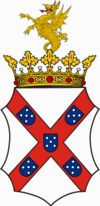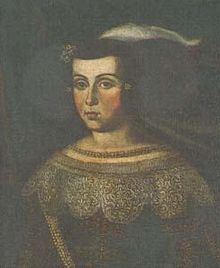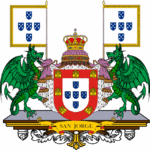- John IV of Portugal
-
John IV 
King of Portugal and the Algarves Reign 1 December 1640— 6 November 1656 Predecessor Philip III Successor Afonso VI Duke of Braganza Reign 29 November 1630— 1 December 1640 Predecessor Teodósio II Successor Teodósio III Spouse Luisa of Medina-Sidonia Issue Teodósio, Prince of Brazil
Joana, Princess of Beira
Catherine, Queen of England
Afonso VI of Portugal
Peter II of PortugalHouse House of Braganza Father Teodósio II, Duke of Braganza Mother Ana de Velasco y Girón Born 18 March 1603
The Ducal Palace of Vila Viçosa, Vila Viçosa, Kingdom of PortugalDied 6 November 1656 (aged 53)
Ribeira Palace, Lisbon, Kingdom of PortugalBurial Dynasty of Braganza Royal Pantheon, Monastery of São Vicente de Fora, Lisbon, District of Lisbon, Portugal Religion Roman Catholicism John IV (Portuguese: João IV de Portugal, pronounced: [ʒuˈɐ̃w̃]; 18 March 1603 – 6 November 1656) was the King of Portugal and the Algarves from 1640 to his death. He was the grandson of Catherine, Duchess of Braganza, who had in 1580 claimed the Portuguese crown and sparked the struggle for the throne of Portugal. John was nicknamed John the Restorer (João o Restaurador). On the eve of his death in 1656, the Portuguese Empire reached its zenith, spanning almost 3,000,000,000 acres (12,000,000 km2).
Contents
Biography
Succession
John was born at Vila Viçosa and succeeded his father Teodósio II as Duke of Braganza when the latter died insane in 1630. He married Luisa de Guzman (1613–1666), eldest daughter of Juan Manuel Pérez de Guzmán, 8th Duke of Medina Sidonia, in 1633. He was raised to the throne of Portugal (of which he was held to be the legitimate heir) during the revolution on 1 December 1640, against the Spanish king Philip IV.
His accession led to a protracted war (the Portuguese Restoration War) with Spain, which only ended with the recognition of Portuguese independence in a subsequent reign (1668). Portugal signed alliances with France (1 June 1641) and Sweden (August 1641) but by necessity its only contributions in the Thirty Years' War were in the field against Spain and against Dutch encroachments on the Portuguese colonies.
In Spain, a Portuguese invasion force defeated the Spanish at Montijo, near Badajoz, in 1644. Abroad, the Dutch took Malacca (Jan 1641) and the Sultan of Oman captured Muscat (1650). Nevertheless the Portuguese, despite having to divide their forces among Europe, Brazil and Africa, managed to retake Luanda, in Angola, from the Dutch in 1648 and, by 1654, had recovered most of Brazil, effectively ceasing to be a viable Dutch colony. This was countered by the loss of Ceilan (Portuguese Ceilão), present day Sri Lanka, to the Dutch who took Colombo in 1656.
Death and legacy
King John IV died in 1656 and was succeeded by his son Afonso VI. His daughter, Catherine of Braganza, married King Charles II of England.
John was a patron of music and the arts, and a considerably sophisticated writer on music; in addition to this, he was a composer. During his reign he collected one of the largest libraries in the world, but it was destroyed in the Lisbon earthquake of 1755. Among his writings is a defense of Palestrina, and a Defense of Modern Music (Lisbon, 1649). His most famous composition is a setting of the Crux fidelis, a work that remains highly popular during Lent amongst church choirs.
Marriages and descendants
John married Luisa de Guzman, daughter of Juan Manuel Pérez de Guzman, 8th Duke of Medina-Sidonia. From that marriage several children were born. Because some of John's children were born and died before their father became king they are not considered infantes or infantas of Portugal.
Name Birth Death Notes By Luisa de Guzman ( 13 October 1613 – 27 February 1666; married on 12 January 1633) Infante Teodósio 8 February 1634 13 May 1653 Prince of Brazil and 9th Duke of Braganza. Died young. Ana de Bragança 21 January 1635 21 January 1635 Infanta Joana (Joan) 18 September 1635 17 November 1653 Infanta Catarina (Catherine) 25 November 1638 31 December 1705 Commonly known as Catherine of Braganza. Queen consort through marriage to Charles II of England. Manuel de Bragança 6 September 1640 6 September 1640 Infante Afonso 21 August 1643 12 September 1683 Prince of Brazil and 10th Duke of Braganza. Succeeded him as Afonso VI, 21st (or 22nd according to some historians) King of Portugal. Infante Pedro (Peter) 26 April 1648 9 December 1706 Duke of Beja, Constable of the Kingdom, Lord of the House of Infantado and Regent of the Kingdom before succeeding his brother Afonso as Peter II, 22nd (or 23rd according to some historians) King of Portugal. Illegitimate offspring Maria de Bragança 30 April 1644 7 February 1693 Natural daughter. Ancestry
Ancestors of John IV of Portugal 16. James, 4th Duke of Braganza (=#22) 8. Teodósio I, 5th Duke of Braganza 17. Leonor de Mendoza (=#23) 4. John I, 6th Duke of Braganza 18. Denis of Braganza, Count of Lemos 9. Isabel de Lencastre 19. Beatriz de Castro Osório, 6th Countess of Lemos 2. Teodósio II, 7th Duke of Braganza 20. Manuel I of Portugal 10. Infante Edward, 4th Duke of Guimarães 21. Maria of Aragon 5. Infanta Catherine of Guimarães 22. James, 4th Duke of Braganza (=#16) 11. Isabella of Braganza 23. Leonor de Mendoza (=#17) 1. John IV of Portugal 24. Juan Sancho de Tovar, 1st Marquis of Berlanga 12. Íñigo Fernández de Velasco, 4th Duke of Frías 25. Juana Enriquez de Ribera y Portocarrero 6. Juan Fernández de Velasco, 5th Duke of Frías 26. Juan Alfonso Pérez de Guzmán, 6th Duke of Medina Sidonia (=#30) 13. Maria Angela de Aragón y Guzmán 27. Ana de Aragón y de Gurrea (=#31) 3. Ana de Velasco y Girón 28. Juan Téllez-Girón, 4th Count of Ureña 14. Pedro Téllez-Girón, 1st Duke of Osuna 29. María de la Cueva y Toledo 7. Maria Tellez-Giron 30. Juan Alfonso Pérez de Guzmán, 6th Duke of Medina Sidonia (=#26) 15. Leonor Ana de Guzmán y Aragón 31. Ana de Aragón y de Gurrea (=#27) References
 This article incorporates text from a publication now in the public domain: Chisholm, Hugh, ed (1911). Encyclopædia Britannica (11th ed.). Cambridge University Press.
This article incorporates text from a publication now in the public domain: Chisholm, Hugh, ed (1911). Encyclopædia Britannica (11th ed.). Cambridge University Press.
External links
- Free scores by John IV of Portugal in the Choral Public Domain Library (ChoralWiki)
- Crux fidelis Recording of John's best-known choral work
John IV of PortugalBorn: 19 March 1603 Died: 6 November 1656Regnal titles Preceded by
Philip IIIKing of Portugal and the Algarves
1640–1656Succeeded by
Afonso VIHouse of Braganza John IV Children
Peter II Children includeIsabel Luísa, Princess of Beira · John V · Francisco, Duke of Beja · António · Manuel, Count of Ourém · Infanta Francisca · Luísa, Duchess of Cadaval (natural daughter) · José, Archbishop of Braga (natural son)
John V ChildrenJoseph I Children includeMaria I and Peter III Children includeJohn VI Children includeMaria Teresa, Princess of Beira · Maria Isabel, Queen of Spain · Pedro IV of Portugal · Maria Francisca · Isabel Maria · Miguel I · Maria da Assunção · Infanta Ana de Jesus Maria, Duchess of LouléPedro IV Children includeGrandchildrenAfonso, Prince Imperial of Brazil · Isabel, Princess Imperial of Brazil · Leopoldina · Pedro, Prince Imperial of BrazilMiguel ChildrenMaria das Neves · Miguel, Duke of Braganza · Maria Teresa, Archduchess of Austria · Maria Josepha, Duchess in Bavaria · Adelgundes, Duchess of Guimarães, Countess of Bardi · Marie Ana, Grand Duchess of Luxembourg · Maria Antónia, Duchess of ParmaGrandchildrenMiguel, Duke of Viseu · Francis Jospeh · Maria Teresa · Isabel Maria · Maria Benedita · Mafalda · Maria Anna · Maria Antónia · Filippa · Duarte Nuno, Duke of Braganza · Maria AdelaideGreat grandchildrenGreat-great grandchildrenMaria II and Ferdinand II ChildrenPedro V · Luís I · Infante João, Duke of Beja · Infante Maria Anna · Infanta Antónia of Portugal · Infante Ferdinand of Portugal · Infante Augustus, Duke of CoimbraCategories:- Portuguese monarchs
- Portuguese royalty
- Dukes of Braganza
- Dukes of Guimarães
- Dukes of Barcelos
- Portuguese composers
- Baroque composers
- 1603 births
- 1656 deaths
- House of Braganza
- Portuguese infantes
- 17th-century Portuguese people
- Burials at the Monastery of São Vicente de Fora
Wikimedia Foundation. 2010.


